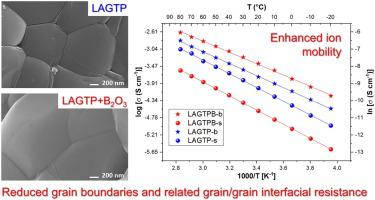Journal of the European Ceramic Society ( IF 5.8 ) Pub Date : 2021-11-10 , DOI: 10.1016/j.jeurceramsoc.2021.11.014
Sofia Saffirio 1 , Marisa Falco 2, 3 , Giovanni B. Appetecchi 4 , Federico Smeacetto 1 , Claudio Gerbaldi 2, 3

|
Li-ion batteries (LIBs) are the ubiquitous technology to power portable electronics; however, for the next-generation of high-performing electrochemical energy storage systems for electric vehicles and smart grid facilities, breakthroughs are needed, particularly in the development of solid-state electrolytes, which may allow for enhanced energy density while enabling lithium metal anodes, combined with unrivalled safety and operative reliability. In this respect, here we present the successful synthesis of a glass-ceramic Li1.4Al0.4Ge0.4Ti1.4(PO4)3 NASICON-type solid-state electrolyte (SSE) through a melt-casting technique. Being grain boundaries crucial for the total ionic conductivity of SSEs, the effect of the addition of diboron trioxide (B2O3, 0.05 wt.%) to promote their liquefaction and restructuring is investigated, along with the effects on the resulting microstructures and ionic conductivities. By the thorough combination of structural-morphological and electrochemical techniques, we demonstrate that bulk materials show improved performance compared to their powder sintered counterpart, achieving remarkable ion mobility (> 0.1 mS cm–1 at –10 °C) and anodic oxidation stability (> 4.8 V vs Li+/Li). The addition of B2O3 positively affects the grain cohesion and growth, thus reducing the extension of the grain boundaries (and the related grain/grain interface resistance) and, therefore, increasing the overall ion mobility. In addition, B2O3 is seen to contrast the microcracks formation in the LAGTP system under study which, overall, shows very promising prospects as SSE for the next-generation of high-energy density, safe lithium-based batteries.
中文翻译:

Li1.4Al0.4Ge0.4Ti1.4(PO4)3 有望用于全固态锂基电池的 NASICON 结构微晶玻璃电解质:揭示三氧化二硼的作用
锂离子电池 (LIB) 是为便携式电子设备供电的普遍技术;然而,对于用于电动汽车和智能电网设施的下一代高性能电化学储能系统,需要突破,特别是在固态电解质的开发方面,这可以提高能量密度,同时使锂金属阳极成为可能,结合无与伦比的安全性和操作可靠性。在这方面,我们在这里介绍了玻璃陶瓷 Li 1.4 Al 0.4 Ge 0.4 Ti 1.4 (PO 4 ) 3的成功合成NASICON 型固态电解质 (SSE) 通过熔铸技术。作为对 SSE 的总离子电导率至关重要的晶界,研究了添加三氧化二硼 (B 2 O 3 , 0.05 wt.%) 以促进其液化和重组的效果,以及对所得微观结构和离子电导率的影响。电导率。通过结构形态学和电化学技术的彻底结合,我们证明散装材料与其粉末烧结对应物相比表现出更好的性能,实现了显着的离子迁移率(在 –10 °C 时> 0.1 mS cm –1)和阳极氧化稳定性(> 4.8 V vs Li + /Li)。B 2 O 3 的添加积极影响晶粒内聚力和生长,从而减少晶界的延伸(以及相关的晶粒/晶粒界面电阻),从而增加整体离子迁移率。此外,B 2 O 3与正在研究的 LAGTP 系统中的微裂纹形成形成对比,总体而言,作为下一代高能量密度、安全锂基电池的 SSE,显示出非常有前景的前景。

































 京公网安备 11010802027423号
京公网安备 11010802027423号